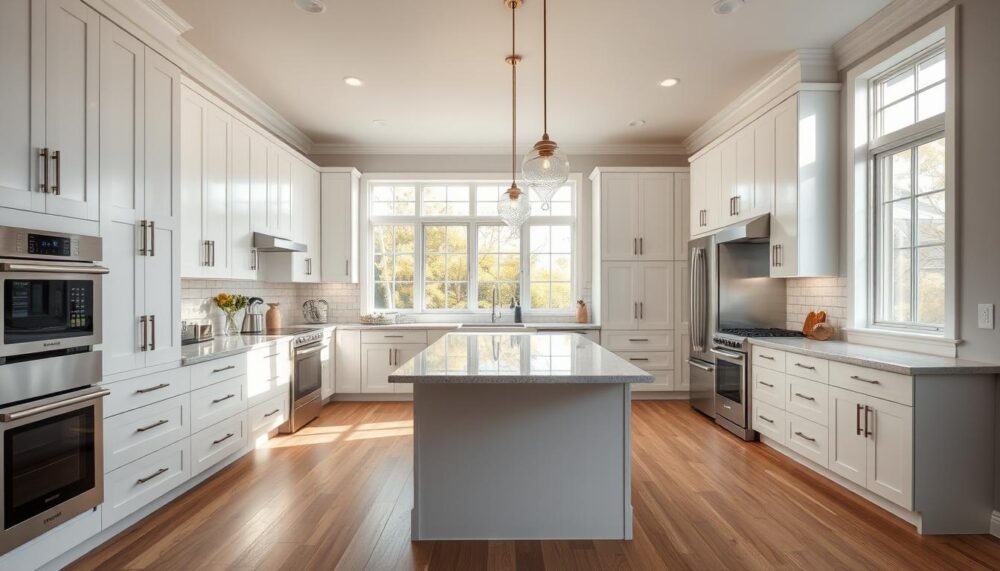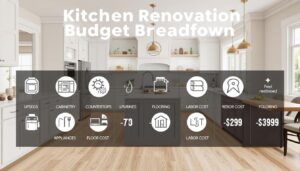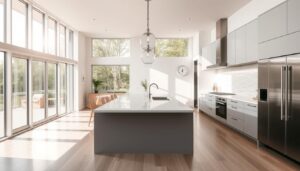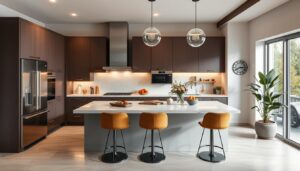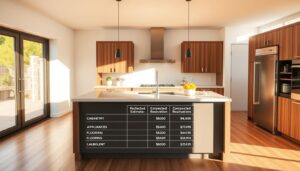Planning a new kitchen can be both exciting and overwhelming. With 2025 on the horizon, understanding the cost involved is crucial for effective budgeting. According to a recent Magnet survey, homeowners typically spend between 5-10% of their property’s value on a kitchen renovation. This benchmark helps set realistic expectations for your project.
January often sees a surge in searches for renovation ideas, as many people plan upgrades after the festive season. This trend highlights the importance of early preparation to avoid common regrets, such as insufficient storage or missing out on features like underfloor heating.
This guide will provide a detailed breakdown of expenses, including cabinets, worktops, and flooring. By referencing Magnet’s survey of 2,000 adults, we aim to offer credible insights to help you make informed decisions for your home improvement journey.
Key Takeaways
- Kitchen renovations typically cost 5-10% of a home’s value.
- January is the peak month for planning upgrades.
- Common regrets include inadequate storage and missing features.
- Detailed cost breakdowns for cabinets, worktops, and flooring are essential.
- Magnet’s survey provides reliable insights for informed decisions.
Introduction to Kitchen Renovation Costs in the UK
Understanding the financial aspects of upgrading your cooking space is essential. Several factors influence the overall costs, including the size of the room, the quality of materials, and the chosen layout. Larger spaces naturally require more resources, while premium finishes can significantly increase expenses.
Smart gadgets are becoming increasingly popular, with homeowners spending an average of £1,188 on these additions. While they add a modern touch, it’s important to weigh their practicality against your budget. Balancing aesthetics with functionality ensures your space remains both stylish and efficient.
Many renovators later express regrets about their choices. A staggering 40% wish they had included more storage, while 17% find themselves short on power sockets. Proper planning can help avoid these common pitfalls.
One feature worth considering is underfloor heating. Not only does it add a touch of luxury, but it’s also energy-efficient, helping to reduce long-term utility bills. By carefully evaluating your needs and priorities, you can create a space that’s both beautiful and practical.
How Much Is the Average Kitchen Renovation in 2025?
Budgeting for a new cooking area requires understanding key expenses. In 2025, homeowners are expected to allocate significant funds to cabinets, worktops, and flooring. These elements form the backbone of any functional and stylish space.
Average Spend on Kitchen Cabinets
Cabinets are often the most substantial investment, averaging £4,477. Over half of homeowners spend under £5,000, but quality plays a crucial role in longevity. Cheaper units may save money upfront but could lead to higher maintenance costs later.
Interestingly, 10% of renovators regret underspending on cabinets. Prioritising durable materials ensures your units withstand daily wear and tear. Custom designs, while pricier, offer tailored storage solutions.
Cost of Kitchen Worktops and Flooring
Worktops are another major expense, with an average spend of £2,985. Materials like quartz and laminate vary in cost and durability. Quartz, though more expensive, offers a sleek finish and resilience, while laminate is a budget-friendly alternative.
Flooring, averaging £2,653, is equally important. Vinyl and hardwood are popular choices, each with its trade-offs. Vinyl is affordable and easy to maintain, while hardwood adds timeless elegance. However, 15% of homeowners wish they had invested more in their flooring.
| Material | Average Cost | Pros | Cons |
|---|---|---|---|
| Quartz Worktops | £2,500 – £4,000 | Durable, low maintenance | Higher upfront cost |
| Laminate Worktops | £1,000 – £2,000 | Affordable, versatile | Less durable |
| Vinyl Flooring | £1,500 – £2,500 | Budget-friendly, easy to clean | Less luxurious |
| Hardwood Flooring | £3,000 – £5,000 | Timeless, adds value | Higher maintenance |
Hidden costs, such as installation and plumbing adjustments, can also impact your budget. According to Magnet’s data, over-65s tend to spend more, averaging £13,000 on their projects. Planning for these expenses ensures a smoother renovation process.
Key Factors Affecting Kitchen Renovation Costs
Several elements can significantly influence the final price of your project. From the size of your space to the quality of materials, each decision impacts your budget. Understanding these factors ensures you make informed choices that align with your vision and financial plan.
Size and Layout of Your Kitchen
The space available plays a crucial role in determining costs. Larger areas require more resources, from cabinetry to flooring. Smaller kitchens, while less expensive, demand clever layout solutions to maximise functionality.
Open-plan designs are increasingly popular, but they often involve higher labour costs due to structural changes. Traditional layouts, on the other hand, may be more straightforward but can limit storage options. Jen Nash, a renowned interior designer, advises,
“Balancing style and functionality is key to creating a space that works for your lifestyle.”
Quality of Materials and Appliances
Choosing the right materials is essential for durability and aesthetics. Solid wood cabinets, for example, offer longevity but come at a higher price compared to MDF alternatives. Similarly, quartz worktops provide a sleek finish, while laminate is a budget-friendly option.
Appliances also contribute to the overall cost. Energy-efficient models may have a higher upfront price but lead to long-term savings on utility bills. Bespoke designs, though 2-3 times more expensive than pre-fabricated units, allow for customised solutions that perfectly fit your layout.
By prioritising quality and thoughtful planning, you can create a kitchen that’s both beautiful and practical, without overspending.
Planning Your Kitchen Renovation: What to Consider
Embarking on a kitchen upgrade requires careful thought and preparation. A well-planned project ensures you stay within your budget while achieving the desired look and functionality. Whether you’re aiming for a timeless design or a trendy makeover, understanding the essentials is key.

Setting a Realistic Budget
Creating a detailed budget is the first step. Include costs for materials, labour, and unexpected expenses. A contingency fund of 10-15% is advisable to cover surprises. According to recent data, 22% of homeowners overspent on cabinets, while 35-44-year-olds invested most in worktops.
Consider the return on investment (ROI) when choosing materials. Timeless options like quartz worktops may cost more upfront but add long-term value. Avoid overspending on fleeting trends, especially those inspired by social media platforms like TikTok.
Choosing the Right Design and Layout
The layout of your kitchen significantly impacts its functionality. Open-plan designs are popular but may require structural changes, increasing costs. Traditional layouts can be more cost-effective but may limit storage options.
Professional consultations, such as Magnet’s free design service, can provide valuable advice. Jen Nash, an interior designer, suggests,
“Future-proof your space by prioritising storage and workflow efficiency.”
This ensures your kitchen remains practical for years to come.
DIY projects can be tempting, but they often lead to costly mistakes. Hiring experts for complex tasks ensures a polished finish and avoids common pitfalls. By balancing aesthetics with practicality, you can create a kitchen that’s both beautiful and functional.
Where to Invest More in Your Kitchen Renovation
Deciding where to allocate your budget during a kitchen upgrade can make all the difference. Focusing on key elements ensures your space remains both functional and stylish for years to come. From durable units to energy-efficient features, strategic investments can elevate your dream kitchen.
Investing in Quality Cabinets
Cabinets are the backbone of any kitchen, and skimping on them often leads to regrets. According to Magnet’s data, 10% of homeowners wish they had spent more on durable units. High-quality materials, like solid wood, withstand daily wear and tear, ensuring longevity.
Custom designs, though pricier, offer tailored storage solutions that maximise space. Features like pull-out shelving and larders not only enhance functionality but also add value to your home. As Jen Nash, an interior designer, notes,
“Investing in quality cabinets ensures your kitchen remains practical and stylish for decades.”
Upgrading to Underfloor Heating
Underfloor heating is a luxurious yet practical addition to any kitchen. Compared to traditional radiators, it provides even warmth and frees up wall space. While the initial cost is higher, the energy efficiency and added resale value make it a worthwhile investment.
For those prioritising comfort and sustainability, underfloor heating is a game-changer. It’s particularly beneficial in larger kitchens, where traditional heating systems may struggle to maintain consistent temperatures.
| Feature | Cost | Benefits |
|---|---|---|
| Solid Wood Cabinets | £4,000 – £6,000 | Durable, timeless, adds value |
| Underfloor Heating | £2,500 – £4,000 | Energy-efficient, space-saving |
| Quartz Worktops | £2,500 – £4,000 | Low maintenance, sleek finish |
By prioritising quality and thoughtful planning, you can create a kitchen that’s both beautiful and practical. Whether it’s durable units or innovative heating solutions, these investments ensure your dream kitchen becomes a reality.
Top Tips to Save Money on Your Kitchen Renovation
Renovating your cooking space doesn’t have to break the bank if you know where to cut costs. With a few smart choices, you can achieve a stylish and functional kitchen without overspending. Here are some practical tips to help you stay within your budget.
Saving on Splashbacks and Lighting
Splashbacks and lighting are essential elements, but they don’t have to be expensive. Opt for acrylic instead of glass for your splashback. It’s a cost-effective alternative that still looks sleek and modern.
When it comes to lighting, strategic placement of LED strips can replace costly pendant lighting grids. This approach not only saves money but also creates a contemporary look. The average spend on lighting is £569, but with careful planning, you can reduce this significantly.
Avoiding Unnecessary Smart Gadgets
Smart gadgets may seem appealing, but they’re often unnecessary. According to recent data, 50% of renovators skipped them entirely, and 55% actively avoided them. Focus on essentials rather than trendy add-ons that may not add value to your daily routine.
Reusing existing plumbing is another way to save. Rerouting pipes can cost over £1,500, so if your current setup works, stick with it. This simple decision can free up funds for other priorities.
| Feature | Cost-Saving Tip | Potential Savings |
|---|---|---|
| Splashbacks | Use acrylic instead of glass | Up to £300 |
| Lighting | Opt for LED strips over pendant grids | Up to £200 |
| Smart Gadgets | Avoid unnecessary tech | Up to £1,000 |
| Plumbing | Reuse existing setup | Up to £1,500 |
For those who need financial flexibility, Magnet offers interest-free credit and buy-now-pay-later options. These can help spread the cost of your renovation, making it more manageable. By focusing on these tips, you can create a stunning kitchen without straining your budget.
Common Kitchen Renovation Regrets and How to Avoid Them
Creating a functional and stylish cooking area often comes with unexpected challenges. Many homeowners later regret decisions that impact their daily routines. By understanding these pitfalls, you can plan effectively and avoid common mistakes.
Lack of Storage and Worktop Space
One of the most frequent regrets is insufficient storage. According to recent data, 40% of homeowners wish they had more larders or pantry space. Prioritising aesthetics over practicality often leads to this issue, with 21% admitting they focused too much on the design.
Kitchen islands have become a popular solution, offering both additional worktop space and storage. With an average spend of £5,276, they serve as multifunctional hubs. TikTok trends like #kitchenstorage also highlight creative ways to maximise room without compromising style.
Jen Nash, an interior designer, advises,
“Quantify your storage needs early in the planning process to avoid regrets later.”
Insufficient Power Sockets
Another common issue is the lack of power sockets, with 17% of renovators facing this problem. Modern kitchens require ample sockets for appliances, gadgets, and charging devices. Allocating a minimum number per zone—prep, cooking, and social—ensures seamless functionality.
Here’s a quick guide to socket placement:
| Zone | Recommended Sockets |
|---|---|
| Prep Area | 2-3 |
| Cooking Area | 2-3 |
| Social Area | 1-2 |
By addressing these things early, you can create a kitchen that’s both practical and beautiful, avoiding regrets that often arise post-renovation.
Conclusion: Achieving Your Dream Kitchen Within Budget
Achieving your dream cooking space while staying within budget is entirely possible with the right approach. As a rule of thumb, allocating 5-10% of your home’s value ensures a balanced project. For instance, cabinets average £4,477, but investing in quality materials like quartz worktops or underfloor heating can offer long-term savings.
To avoid common regrets, consider booking a free design consultation. Tailored solutions, such as door replacements or full refits, can adapt to different budgets. Magnet’s finance options, including 0% APR and 6-year payment plans, make your dream kitchen more accessible.
Ready to start? Book a free appointment to design your 2025 kitchen today and turn your vision into reality.
FAQ
What influences the cost of a new kitchen?
The price depends on factors like the size of the room, the quality of materials, and the appliances you choose. Layout changes and additional features like underfloor heating can also affect the total spend.
How can I save money on my project?
Focus on cost-effective upgrades like splashbacks and lighting. Avoid unnecessary smart gadgets and stick to a well-planned budget to keep costs in check.
What are common regrets during renovations?
Many homeowners wish they had added more storage, worktop space, or power sockets. Planning your layout carefully can help avoid these issues.
Where should I invest more in my kitchen?
Prioritise quality cabinets and durable worktops. Upgrading to features like underfloor heating can also add long-term value to your home.
How do I set a realistic budget?
Start by researching costs for materials, appliances, and labour. Allocate funds for unexpected expenses and stick to your priorities to avoid overspending.
What should I consider when choosing a design?
Think about your lifestyle, the room’s layout, and the overall style you want. Ensure the design maximises space and functionality while reflecting your personal taste.

